-
Posts
429 -
Joined
-
Last visited
-
Days Won
1
Content Type
Profiles
Forums
Blogs
Gallery
Events
Store
Posts posted by GRA
-
-
Hello Mike!
Try this link: http://lib.militaryarchive.co.uk/library/infantry-histories/library/The-History-of-The-Duke-of-Cornwalls-Light-Infantry-1914-1919/files/assets/basic-html/page512.html It seems like the maps are messed up but the text should be OK.
/Jonas
0 -
Hello Kevin!
You may find this map from "The Story of the Twenty-Third Hussars 1940-1946" interesting, as well as a link to download "History of 15th-19th The King's Hussars 1939-1945" (21.16mb). 23rd Hussars served in the 29th Armoured Brigade and 15th/19th The King's Hussars was with the divisional troops of the 11th Armoured Division. http://www.lightdragoons.org.uk/downloads.html
/Jonas
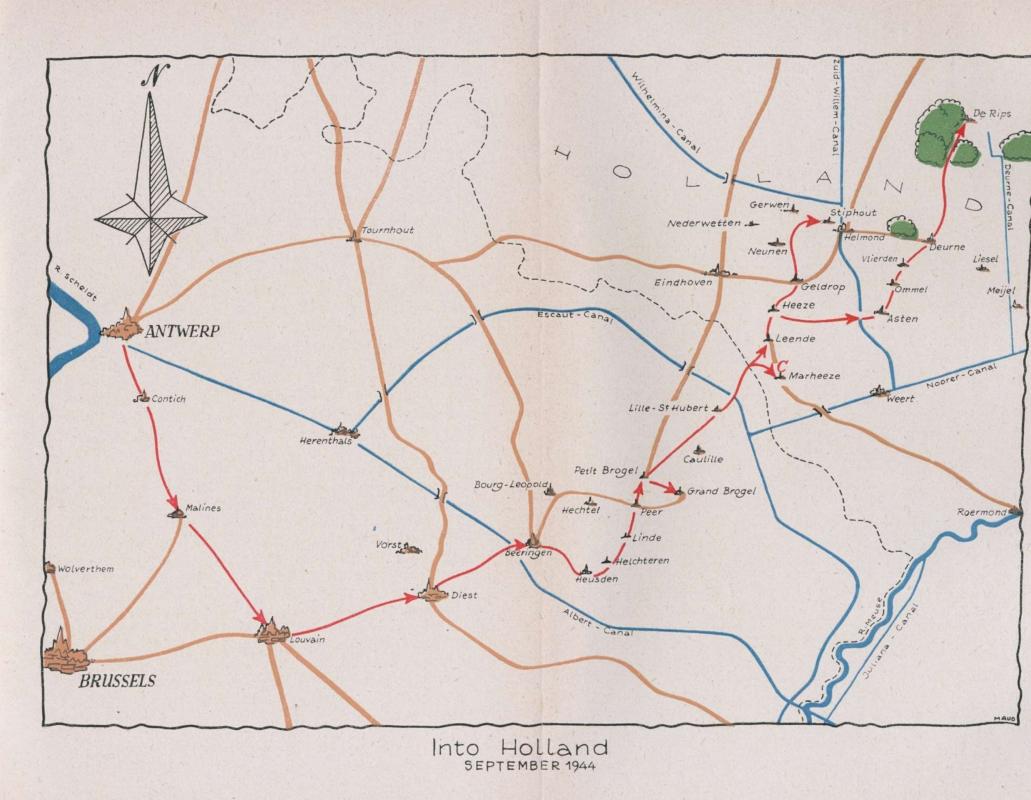 0
0 -
Post #2 looks like the TRF of The Rifles.
/Jonas
0 -
They were part of 1HCR, a composite regiment formed in 1939 by the Household Cavalry intended for deployment overseas. The regiment ended up in Habbaniya Task Force - Habforce. Trooper Shone (B Sqn) is mentioned in "Horse Guards" (page 512) by Barney White-Spunner.
/Jonas
0 -
Jonas, thanks for the info on the books!
You're welcome Rick! There's more in "History of the 4th/7th Royal Dragoon Guards" (1982) by J.M. Brereton, chapter XIII "The Great War" section 1. "First Blood". A corporal Ernest Thomas of 4th Tp C Sqn are mentioned as having fired the first rifle shot of the war on 22nd August.
In the 4th/7th DG book is also mentioned No 4 gun of E Battery RHA as having fired the first artillery round at 1115 hours on 22nd August at Bray (Mons-Charleroi road).
/Jonas
0 -
"Teenage Tommy - Memoirs of a Cavalryman in the First World War" (1996, reprinted 2013) by Richard Van Emden - the memoirs of trooper Benjamin Clouting of the 4th (Royal Irish) Dragoon Guards is well worth reading. Among its contents are descriptions of the action at Casteau on the 22nd as well as the charge at Audregnies on the 24th.
"Record of the 4th Royal Irish Dragoon Guards in the Great War 1914-1918" (1925, reprinted 2002) by Rev Harold Gibb contains six pages on those early actions of the war.
/Jonas
0 -
Here are some scans from "Undervisning för ryttaren" ("Instruction for the trooper") - basically a "soldier's bible" containing all information he needed, from patriotic stories(!) and army organisation to anatomy of the horse. My book once belonged to a corporal from my regiment who served in the early 1920's.
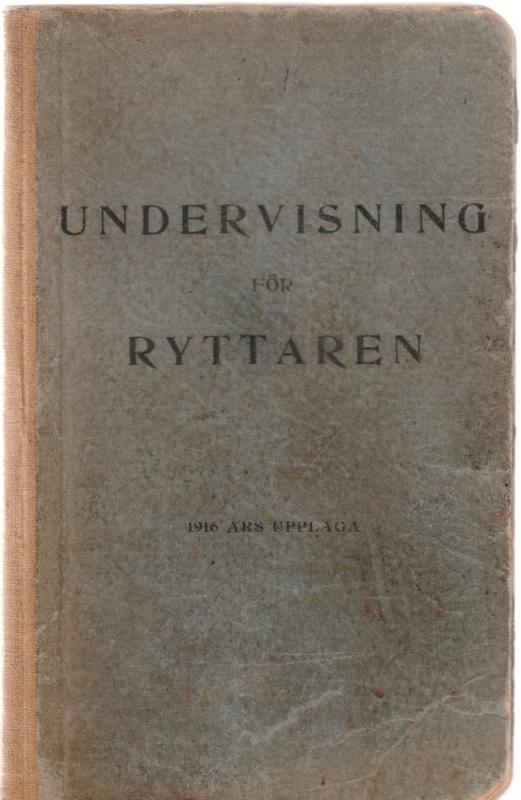

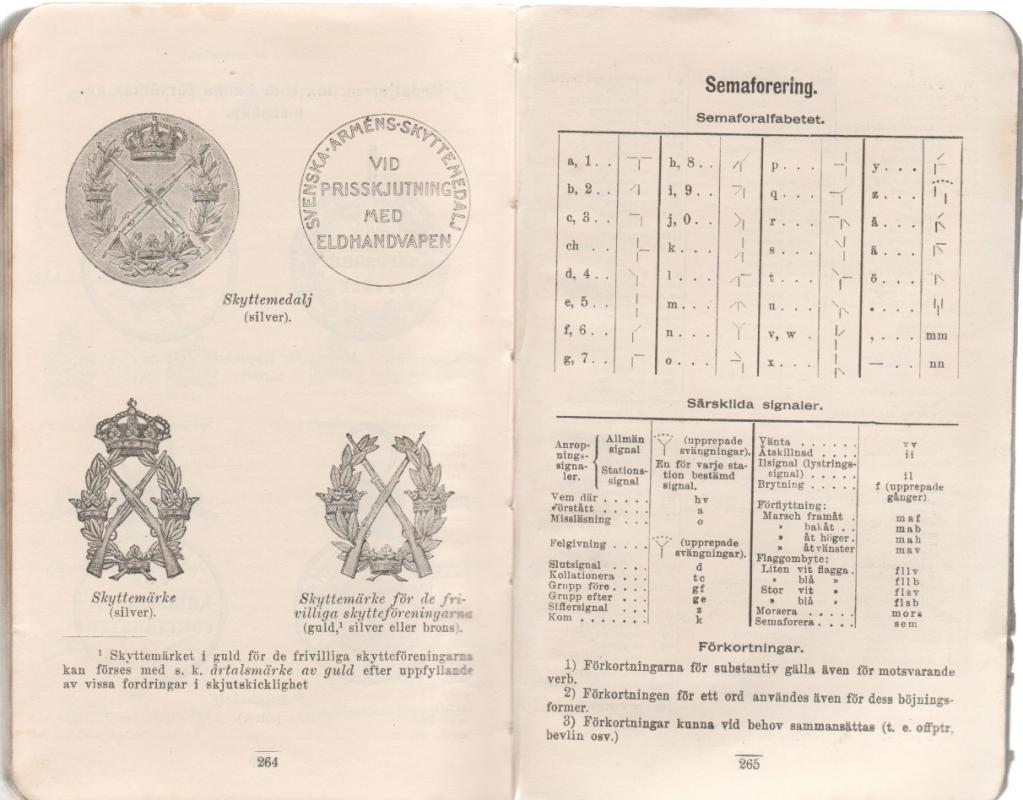
The normal shooting awards (the ones with crossed rifles) dates from 1907 and the MG awards dates from 1918.
- Gold medal with enamel (silver medal 10 consecutive years)
- Gold medal (silver medal 5 consecutive years)
- Silver medal (plus a small sum of money)
- Silver badge (plus a small sum of money)
- Silver badge
The link contains pictures of the awards - "Arméns skyttemedalj..." and "Arméns kulspruteskyttemedalj..." are the relevant ones.
http://medalj.nu/ribbon_list.asp
/Jonas
0 -
Hello medalman90!
This is a normal award for shooting with support weapons. It also exists with crossed rifles for shooting with rifles, assault rifles, sub-machine guns and pistols. This "medal" also exist in gold after re-qualifying for five consecutive years, a gold with blue enamel "medal" also exist (at least for the small arms version), if not reaching "medal" level, a silver badge could also be awarded. As I recall, when I did my national service 25 years ago, it may have been awarded also for ATGW shooting, not only for MG shooting. I think a small sum of money was also included in the award, the badge was awarded with and without money, thus the it has the name of "price-shooting medal" - an award with a sum of money to be won with it. As to the age, well, the crossed rifles version is shown in the "Undervisning för ryttaren", 1916 edition.
/Jonas
0 -
The old and new (from 2013) patches of the regiment. The new green and black patch consists of a shield and a separate tab, both are embroidered on a velcro backing. The regimental Ranger tab is now worn on the right arm, though I can't remember ever seeing one worn together with the old regimental patch. I have, however, seen one of the new "Livregementets husarer" tabs worn with a battalion patch.
 0
0 -
uniquely American.
Not necessarily! Twenty-something years ago graduates of technical gymnasium (roughly high school level, graduating at age twenty - normally!) in Sweden could obtain a 18K gold ring for wear on the left hand. As that particular branch of gymnasium was four years instead of the normal three, the extra year was the "ring-qualifying" year (though it wasn't mandatory as the final grades for applying to university was given at the "normal" end of gymnasium after the third year). I still wear mine with pride as its design is unique among those rings, normally the technical gymnasium rings are similar, but my school's design stands out from the rest.
/Jonas
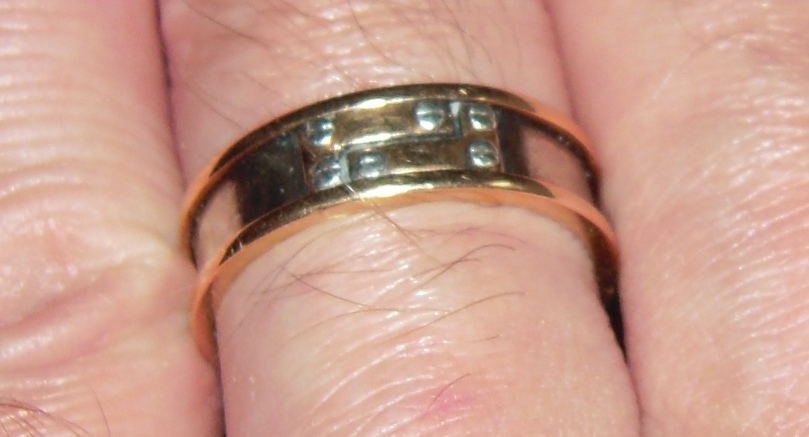 0
0 -
All of the above comes from Buttery, I once bought it to learn more about Louis Nolan the man, but it certainly has some interesting information on the side too! One cannot help thinking what would have become of him had he survived the Crimean War, he was after all one of the most experienced officers of his age and rank in the British army at the time.
I'm not sure it was a case of direct purchase of a commission as in the British army. Money was certainly involved when obtaining a place at a cadet school ("school fees" etc?), but one had to be approved by regimental proprietor - the Inhaber - in order to be accepted as a cadet at all. Patronage would be closer to the truth than purchase.
/Jonas
0 -
Thanks for this additional information, Jonas (7th or 10th Hussars btw?). It prompted me to look at the Militär-Schematismus for 1839 to see if I could find Achilles. I couldn't but did find an entry, again in the 10 HR - as a cadet, for their youngest brother, Edmund! Interestingly, that very British term 'Esq' is used as an indicator of rank.
https://archive.org/stream/militrschematis07kriegoog#page/n350/mode/1up
He appears not to last long as he doesn't appear in the Militär-Schematismus for 1840
 (although his brother Ludwid is, surprisingly). I wonder if all three brothers 'jumped ship' at about the same time?
(although his brother Ludwid is, surprisingly). I wonder if all three brothers 'jumped ship' at about the same time?It seems like "Achilles" was tied to the 10th as a cadet, but confirmed as a subaltern in the 7th. Edmond Nolan entered the 10th Hussars even though Nolan Sr originally bought him a place in the 5th Hussars. Louis Nolan served at the time of the coronation of Queen Victoria. As both Archibald and Louis were confirmed in May 1835 and the former resigned within a year, he has to have been out in the spring of 1836 while Louis certainly served two years after. Louis was commissioned in the 15th Light Dragoons in the spring of 1839.
/Jonas
0 -
Ludwig Nollan - 10 Husaren-Regiment, also know as ...
... Captain (Lewis Edward) Nolan of Charge of the Light Brigade fame. I will start by posting the first two paragraphs from his entry in the Oxford National Dictionary of Biography,
Wikipedia expands a bit on his early military training and career: http://en.wikipedia.org/wiki/Louis_Nolan#Early_life_and_education
In any event, it seems to me that he was, effectively, a deserter from the Austro-Hungarian army

The first mention that I can find of him in the Militär-Schematismus is that for the year 1833 (see link below and attached images).
https://archive.org/stream/militrschematis03austgoog#page/n351/mode/1up
Interestingly, a fellow cadet is 'Achilles Nollan', who, I would suggest, was Lewis/Ludwig's eldest brother Archibald. Archibald, along with some details of their father, is mentioned here
http://www.ucl.ac.uk/lbs/person/view/420034346
Hello Trooper_D!
It seems like Louis Nolan quit Austro-Hungarian service more in "bad standing" than as a deserter but I agree, his actions could have been smoother, and yes, "Achilles" was his older brother Archibald. Archibald Nolan resigned from his commission in the 7th Hussars within a year. Source; "Messenger of Death" by David Buttery.
/Jonas
0 -
Hello all!
While I do not know what it is, I know what it is not! - It's not the Coat of Arms of Carl von Linné, see below. The motto is, as Mervyn say, the same though.
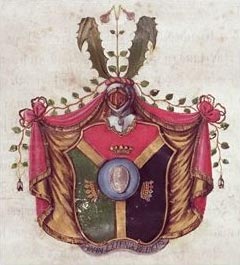
/Jonas
0 -
Happy New Year to both of you! Steve, it sounds good to start the new year with a new field of collecting, and Gordon, I look forward to see your uniforms whenever they turn up!
/Jonas
0 -
Hello Steve!
"...as to been sewn on a uniform, I take it the moleskin field blouse was the item of uniform these badges would have applied to..................either the arms or chest positions ? Does any one have any period photographs showing these badges in wear ?..."
I found some photos on internet of 3./PzGrenBtl72 from the mid-90's showing their patch (http://gmic.co.uk/index.php/topic/54016-bundeswehr-unit-patches/#entry494151) being worn on the upper left sleeve on both moleskin and camouflage uniforms (even on both uniforms in the same photo!), the battalion breast badge was also worn together with the patch. My patches from that battalion (3.Kp and 7.Kp) shows signs of having been worn. PzGrenBtl72 was a regular battalion, so I assume there had to have been at least a silent approval from the chain of command for the wearing of company patches, or was it up to the CO to decide?
/Jonas
0 -
Hello Steve!
First, some of your questions regarding the wearing of these patches are - I hope - answered in this thread: http://gmic.co.uk/index.php/topic/54016-bundeswehr-unit-patches/
Second, the ID of some of the patches:
"P453" - PzAufklKp 400 (armoured recce coy)
"H62" - 3.Kp/AufklLBtl 3
Among the other patches I see Anti-Aircraft (both a Gepard armoured unit -"P452" - and a Patriot missile unit - "A940"), a sub-unit from Gebirgsjägerbrigade 23 - "U88" - (I assume, as the brigade badge is centered on it) and possibly also a MP unit - "H51".
/Jonas
0 -
In "U.S. Military Shoulder Patches of the United States Armed Forces" 5th ed (Britton & Washington Jr), a yellow on dark khaki / brown Remagen tab is shown for the 9th Armored Division (same design for the 4th-9th Armoured Divisions, black on yellow for 1st-3rd Armored Divisions, among others).
/Jonas
0 -
Hello Rick!
Well, first, the colour of the triangle border looks a bit off. As I recall, the border seam of US patches matches the colour of the dress uniform, and I'm not sure this one does. Second, did the 9th Armored Division ever have the tab attached? The patch-tab combination is - to my knowledge - a later construction. Nevertheless, it has a story behind it, which certainly gives it a place in the collection!
In the Plzen area there's quite a number of 16th Armored Division patches floating around - some WW2 vintage, some most probably not - and they don't look similar to this patch (no tab - the 16th never wore a tab - and different colour of the border seam).
/Jonas
0 -
Hello Chris!
The lid looks older than it is! I'm 100% certain (well, 99) that it is as modern as the mug (that is around 2000). The EK 1914 was probably chosen because it is the most well-known version (or the second most well-known but more PC version of the two!). I wouldn't be surprised if there's more beer mugs like this one from different BW units out there, I know that my friend had an almost identical mug, if mine is of the brigade HQ Coy, then his was probably of the brigade (the bridge/background colours were reversed).
/Jonas
0 -
http://gmic.co.uk/index.php/topic/46967-pionierbrigade-80/#entry433053
Modern unit, but still the EK 1914...
/Jonas
0 -
Hello danio!
What you have is a miniature from the Royal Swedish Patriotic Society, "For long and valued work effort". There should be silver hallmarks somewhere, but it is an earlier issue of the king Carl XVI Gustaf version.
/Jonas
0 -
The peacetime establishment of a cavalry regiment was five squadrons consisting of four troops (Züge). On mobilisation one squadron remained behind as the Ersatz-Eskadron although not necessarily the 5. Eskadron. For example, the Ersatz-Eskadron of Husaren-Regiment Nr. 11 was the 2. Eskadron. There was no such thing as an HQ squadron.
A Beritt has nothing to do with the training of horses; it is an in-barracks grouping equating to a Korporalschaft in the infantry. A Berittführer was the cavalry equivalent of a section commander/squad leader.
Glenn
Were there any pattern regarding as to which squadron being designated the Ersatz-Eskadron, or was it just the least experienced squadron or the squadron with the most suitably qualified NCOs? Or was it down to the old British system of "senior/junior squadron"?
/Jonas
0 -
Without detailed knowledge, it seems like the No. 5 Eskadron were the depot squadron of the regiment, and would thus contain a detachment for training of the horses (and other detachments for recruit training etc). Thus 5.Sqn is a "peace-time" organisation while the regimental war organisation consists of 1.-4.Sqn. There's of course also the possibility that there was a reorganisation of the regiment's war organisation in the early 20th Century, but four sabre squadrons and a depot squadron seems likely.
/Jonas
0




Verlustlisten website help
in Germany: Imperial: Rick (Research) Lundstrom Forum for Documentation and Photographs
Posted
Hello Tony!
Is this the page you wanted? http://files.genealogy.net/verlustlisten/04220.jpeg Just change the page number (in this case from .../04221 to .../04220) after enlarging the picture, no log-on required!
/Jonas